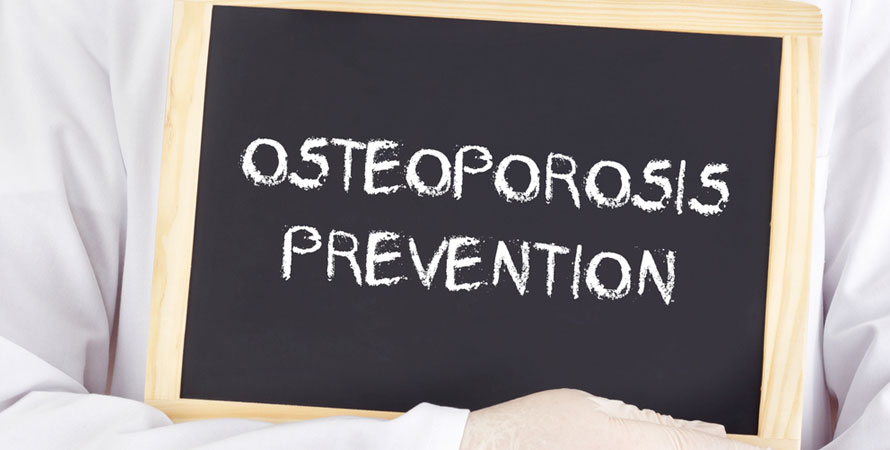What is osteoporosis?
Osteoporosis[1] is a medical condition characterized by low bone density, also called osteopenia, and deterioration of bone tissue, leading to weakened and fragile bones. This occurs because as the body ages, there is a disruption of the balance between the breakdown of old bone tissue and the production of new tissue with low bone density occurring as a result of more tissue breakdown. Osteoporosis is often referred to as a “silent disease” because it develops gradually over time without causing noticeable symptoms in the early stages. Osteoporosis primarily affects older adults, especially postmenopausal women over age 50, but it can also occur in men and younger individuals.
What causes osteoporosis?
There are a variety of factors that contribute to the development of osteoporosis.
- Age: Those older than 50 have a higher chance of developing osteoporosis.
- Hormone changes: Women are more susceptible to osteoporosis than men, especially after menopause.[3],[4]
- Nutritional deficiencies: Inadequate intake of calcium and vitamin D, which are essential for bone health, can increase the risk of osteoporosis.
- Sedentary lifestyle: Lack of regular physical activity and a sedentary lifestyle can contribute to bone loss and weaken the skeletal system.
- Family history: Having a family history of osteoporosis or fractures increases the likelihood of developing the condition.
- Certain medical conditions and medications: Medical conditions, such as rheumatoid arthritis, mineral absorption issues, and hormonal disorders, can contribute to osteoporosis. Additionally, long-term use of certain medications like corticosteroids can lead to bone loss.
- Lifestyle choices: Smoking and excessive alcohol consumption can weaken bones and increase the risk of osteoporosis.
What are the symptoms of early-stage osteoporosis?
In the early stages of osteoporosis[5], it is common for individuals to not experience any noticeable symptoms. However, as the condition progresses, some individuals may begin to experience certain signs that could indicate the presence of osteoporosis. These symptoms may include dental issues such as receding gums; weaker grip strength which is linked to low bone density; weak and brittle fingernails which indicate poor bone health; and bone fractures caused by minor falls usually a pertinent indicator of osteoporosis.
What are the symptoms of late-stage osteoporosis?

In the later stages of osteoporosis[6], the symptoms become more pronounced as the condition progresses and low bone density continues.
- Recurrent bone fractures: Osteoporosis weakens the bones, making them more prone to fractures.
- Loss of height: Osteoporosis can cause gradual compression of the vertebrae in the spine. This compression can lead to a loss of height over time as the bones in the spine become thinner and collapse.
- Back pain: As the vertebrae in the spine become weakened and compressed, individuals may experience persistent or recurrent back pain.
- Poor posture: Osteoporosis-related fractures in the spine can result in a stooped or hunched posture, often referred to as kyphosis.
- Decreased strength and mobility: Weakened bones and the fear of fractures may lead to a decrease in overall strength and mobility. Individuals may find it more challenging to perform daily activities or may become more sedentary to avoid potential injury.
- Gastrointestinal issues: Individuals may experience reduced appetite, bloating, constipation, and abdominal pain.
What are the complications of osteoporosis?
Osteoporosis can lead to various complications[7], particularly when left untreated or poorly managed. As osteoporosis progresses, bone fractures become more common, and even minor falls can lead to major issues in overall health. Chronic pain also becomes a problem caused by these fractures, especially in the spinal area. The pain can be so severe that it becomes debilitating and impacts an individual’s ability to move and work in their everyday life which can reduce quality of life and even lead to loss of their independence. Other complications[8] that can be seen with osteoporosis include depression, hunch in posture and the occurrence of lung and heart issues.
What are the 6 early signs of osteoporosis?
Early signs of osteoporosis may not be noticeable but there may be several indicators that could suggest the presence of the condition. These may also be present in the later stages of osteoporosis as well.
- Recurring fractures: Osteoporosis weakens the bones, making them more susceptible to fractures. Frequent fractures, especially from minor falls or injuries, could be an early sign of osteoporosis. Common fracture sites include the spine, hip, wrist, and ribs.
- Loss of height: Osteoporosis can cause gradual compression of the vertebrae in the spine. This compression leads to a loss of height over time as the bones become thinner and collapse. If you notice a decrease in your height, it may be an early indication of osteoporosis.
- Back pain: Persistent or recurrent back pain, particularly in the lower back, can be an early sign of osteoporosis. The pain may worsen with activities such as bending, lifting, or twisting, and it can be caused by vertebral fractures or spinal deformities resulting from osteoporosis.
- Poor posture: Osteoporosis-related fractures in the spine can lead to a stooped or hunched posture. As the vertebrae collapse, a noticeable curvature of the upper back, known as kyphosis, may develop. This change in posture can be an early visual sign of osteoporosis.
- Brittle nails: Changes in nail health may occur in individuals with osteoporosis. Nails can become brittle, weak, and more prone to breakage. While brittle nails can have various causes, they can be an early indicator of compromised bone health.
- Weakening grip strength: Osteoporosis can affect bone density in the hands and wrists, leading to a decrease in grip strength. If you notice a significant decline in your grip strength, it could be an early sign of osteoporosis.
It’s important to remember that these early signs can also be caused by other factors or conditions, and a proper diagnosis from a healthcare professional is necessary to confirm osteoporosis.
What are some ways to prevent osteoporosis?

Preventing osteoporosis involves adopting a proactive approach to maintain strong and healthy bones.
- Adequate calcium and vitamin D intake are essential for bone health therefore ensuring that you consume good amounts of each through proper nutrition and supplements will aid in preventing osteoporosis.
- Physical activity is another important prevention method, particularly engaging in weight-bearing exercises to both strengthen and promote bone strength and density.
- Avoiding smoking and limiting alcohol can also aid in reducing osteopenia osteoporosis.
- Preventing falls is important as it will reduce bone fractures and chronic pain from developing.
- Taking supplements such as Flexoplex which contain pure, natural ingredients decreases joint pain and inflammation and aids in symptoms such as stiffness and any difficulty in movement. Flexoplex can help to strengthen joints and relieves any discomfort.[9]
Frequently Asked Questions
Osteoporosis pain can start in the affected bones, and the location of the pain depends on where fractures occur. In most cases, the pain begins in the back, particularly in the lower back, as osteoporosis-related fractures commonly affect the vertebrae of the spine. This can result in chronic or intermittent back pain that may worsen with activities such as bending, lifting, or twisting. However, osteoporosis-related pain can also be experienced in other areas such as the hips, wrists, and ribs, depending on the location of the fractures.
The first stage of osteoporosis is characterized by a decrease in bone density without any visible signs or symptoms. During this stage, bone loss occurs gradually and may not be detected without a bone density test. Typically, there are no physical indications or pain associated with the first stage of osteoporosis, making it difficult to identify without medical intervention.
The fastest way to increase bone density involves a combination of weight-bearing exercises and a well-balanced diet rich in essential nutrients. Weight-bearing exercises, such as walking, jogging, dancing, and weightlifting, stimulate the bones and promote bone growth. Additionally, incorporating resistance training exercises can help build and strengthen muscles, which in turn supports bone health. A diet that includes adequate calcium and vitamin D, is crucial for bone density. Quitting smoking and limiting alcohol intake is also beneficial for bone density.
The best indicator of osteoporosis is a bone density test, specifically a dual-energy X-ray absorptiometry (DXA) scan. This test measures bone mineral density and helps diagnose osteoporosis or determine the risk of fractures. The results of the DXA scan are presented as a T-score, which compares an individual's BMD to that of a healthy young adult of the same gender. A T-score of -1 or higher is considered normal, between -1.1 and -2.4 is classified as osteopenia (low bone density), and -2.5 or lower indicates osteoporosis. The DXA scan provides is a valuable tool for assessing bone health and monitoring changes over time.[1]
Conclusion
While osteoporosis may initially present with no noticeable symptoms, the impact of osteoporosis becomes more evident as the disease progresses. Early signs such as recurrent fractures, loss of height, back pain, poor posture, brittle nails, and weakening grip strength should not be ignored. Taking proactive measures for prevention, including proper nutrition, regular exercise, fall prevention, and lifestyle modifications, is crucial in maintaining strong and healthy bones. Additionally, bone density screenings and consultation with healthcare professionals are essential for early detection, diagnosis, and appropriate management of osteoporosis. By adopting a comprehensive approach to bone health, individuals can reduce the risk of fractures, improve quality of life, and promote overall well-being.








